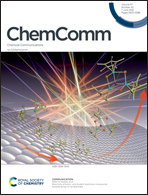UV-vis/X-ray/thermo-induced synthesis and UV–SWIR photoresponsive property of a mixed-valence viologen molybdate semiconductor†
Abstract
A new design strategy through the synergy of Mo(VI)–Mo(V) intervalence charge transfer and π(radical)–π(radical/cation) interactions is proposed to obtain semiconductors with photoresponsive ranges covering the whole UV–SWIR (ultraviolet–shortwave near-infrared; ca. 250–3000 nm) region. With this strategy, a viologen-based molybdate semiconductor with a UV–SWIR photoresponsive range was obtained through UV/X-ray irradiation or thermal annealing. The thermally annealed semiconductor has the highest conversion and the best photocurrent response in the range of 355–2400 nm.



 Please wait while we load your content...
Please wait while we load your content...